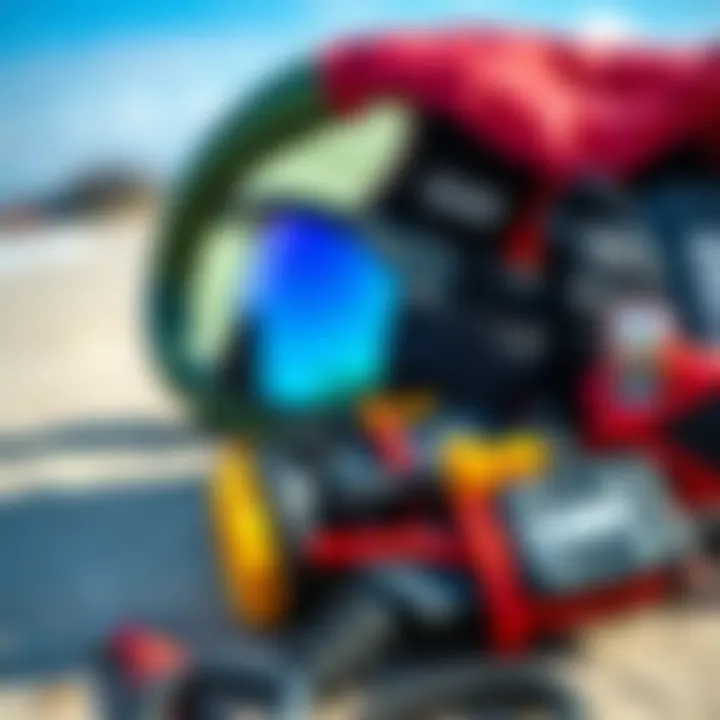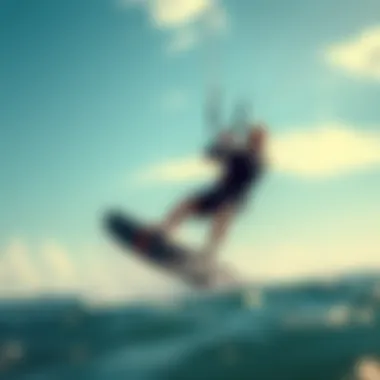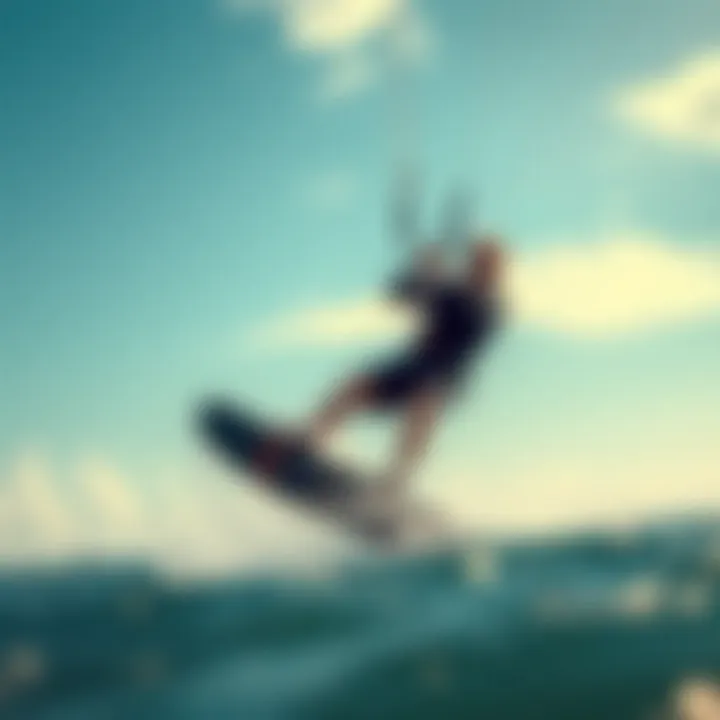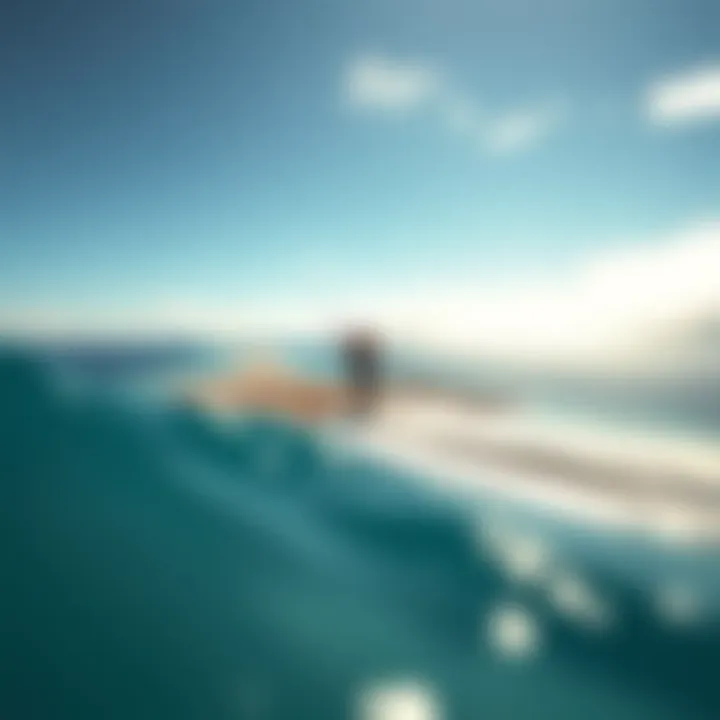Explore Kitopia: Your Ultimate Kiteboarding Guide


Intro
Diving into kiteboarding can feel like stepping into a whole new world. It is not merely a sport; it encapsulates a lifestyle, one that invites thrill and a sense of freedom. At the heart of this adventure lies Kitopia, a concept that signifies the essence of kiteboarding. This guide aims to equip you with vital information to kickstart your journey into this exhilarating realm.
Understanding Kitopia involves more than just feeling the wind on your face or riding the waves. It is about immersing yourself in all facets of kiteboarding, from gear to safety practices. Whether you are a newcomer eager to experience your first flight or a seasoned rider looking to upgrade equipment or refine techniques, this comprehensive guide promises insights tailored to your needs.
With various topics on gear recommendations, safety practices, and techniques for improvement, you’ll find everything you need to enhance your kiteboarding experience. So tighten your harness, let’s set sail into the world of kiteboarding adventures.
Understanding Kitopia
Diving into the realm of Kitopia offers a foundation that every kiteboarder should grasp, whether they're just starting out or seeking to expand their prowess in the sport. This section sets the stage for understanding not just the mechanics of kiteboarding, but its rich cultural backdrop and its meaning in the lives of those who embrace it.
Defining Kitopia
Kitopia represents more than just a destination or sport; it embodies a lifestyle intertwined with adventure, freedom, and connection to nature. At its core, Kitopia is a vibrant community of enthusiasts who share a passion for the thrill of harnessing wind power. The term itself can be thought of as a blend of kite and utopia, a place where kiteboarders find not merely joy but fulfillment and exhilaration. The term isn't found in standard dictionaries but reflects an emerging cultural phenomenon that resonates deeply with individuals who live for wind and waves.
For many, Kitopia is a personal oasis where every kiteboarder contributes to a shared experience. It’s about more than just riding the waves; it’s about respect, growth, and camaraderie. Those who immerse themselves in Kitopia understand that it encapsulates the relentless pursuit of perfect conditions, the joy of mastering new skills, and the thrill of pushing past one’s own limits. In this context, every kiteboarder becomes both a student and a teacher, sharing insights that strengthen the community.
The Culture of Kiteboarding
Kiteboarding isn’t simply an activity; it appears as a subculture with its own language, rituals, and philosophies. The culture thrives on the principles of respect for the environment and fellow riders. Kiteboarders often say, "It’s not just about the ride; it’s about the journey we take together on and off the water!" This kinship transforms the sport into something deeper, as it invites participants into a lifestyle where every wave, every gust of wind, and every adventure shared solidifies bonds.
The kiteboarding community often adopts inclusive practices, welcoming newcomers with open arms and enthusiasm. Events and competitions draw participants from all walks of life, showcasing talent and inspiring others to reach for the sky, literally and metaphorically. Many riders take to online platforms like Reddit and dedicated Facebook groups, where tips and experiences are freely exchanged, and friendships are formed long before meeting face-to-face on the beach.
In essence, the culture of kiteboarding encapsulates the highs and lows of the sport, creating a tapestry of stories that connect individuals through their shared love for the wind. By understanding Kitopia, one can appreciate the rich, multilayered experience that kiteboarding brings to life—one that transcends mere sport and enters the realm of passion and community.
The Essential Gear
In kiteboarding, the right gear can make or break your experience. It's not just about soaring high and slicing through the waves; it's about safety, comfort, and enhancing performance. When you stand on the brink of adventure, you want to feel confident in your equipment. In this section, we will explore the essential components of kiteboarding gear, offering insights that are particularly valuable for both novices and seasoned kiteboarders.
Kites: Types and Selection
Choosing the right kite is akin to selecting the proper tool for a job. Kites come in various shapes, sizes, and designs, each catering to different wind conditions and rider skills. For starters, there are two primary types of kites: Bow kites and C kites. Bow kites are known for their depower capabilities and are easier to handle in gusty winds, making them suitable for beginners. Conversely, C kites are favored by experienced riders for their responsiveness and ability to perform tricks, but they require more skill to control.
When selecting a kite, consider the following factors:
- Wind Conditions: Different kites are targeted for various wind ranges. Lighter kites work well in low winds, while heavier ones are meant for high winds.
- Rider Weight: A kite must be proportional to your weight for optimal performance. Lighter riders may benefit from smaller kites, while heavier riders typically need larger ones.
- Intended Style: Think about what you want to do on the water—whether it's cruising, jumping, or freestyle tricks.
Harnesses: Comfort and Support
A good harness helps you maintain control and enjoy your ride without unnecessary discomfort. Seat harnesses and waist harnesses are popular choices. Seat harnesses are generally more comfortable for beginners as they spread the pull of the kite across your hips and thighs. On the other hand, waist harnesses allow for greater freedom of movement and are preferred by advanced riders.
When choosing a harness, pay attention to:
- Fit: It should fit snugly without constricting your movements. Comfort is key, particularly during long sessions on the water.
- Padding: Look for ample padding that provides support while ensuring you aren't weighed down.
- Attachment Points: Quality harnesses have multiple attachment points for the kite lines, allowing for better control.
Boards: Choosing the Right Fit
The board you ride can impact your performance significantly. Boards vary widely in size, shape, and flex, and picking the right one depends on your skill level and riding style. Freestyle boards, for instance, tend to be lightweight and have a flatter design, making them suitable for trick performers. In contrast, directional boards are narrower and designed for smoother rides in waves.
Here are some points to consider:
- Board Size: Your weight and skill level determine the board size. Lighter or beginner riders might prefer smaller boards for easier handling.
- Construction Materials: The materials used in the board affect performance. Foam-core boards are lightweight and offer good flex, while wood boards may provide better durability.
- Riding Conditions: Think about where you'll be riding. Smooth lakes call for different boards than choppy ocean waters.
Safety Equipment: Must-Haves
Safety should always be top of mind when kiteboarding. Equip yourself with the essentials that ensure your safety out on the water.
Here are the must-have safety items:
- Helmet: A sturdy helmet protects against head injuries from falls or impacts with equipment.
- Impact Vest: This piece of gear adds an extra layer of protection against falls, especially when performing aerial maneuvers.
- Leash: A board leash keeps your board tethered to you, preventing it from drifting away during a fall.
- Emergency Flare or Whistle: This is crucial for signaling distress should you find yourself in trouble far from shore.


By thoroughly understanding your gear, you're not just preparing for a thrilling experience—you're also ensuring your safety and confidence on the water. Remember, the right equipment sets the stage for adventure and the joys of kiteboarding.
Safety Practices
Diving into the thrilling art of kiteboarding without understanding its safety practices can be akin to going into battle without armor. It is crucial for both your well-being and the experience of others on the water. Kiteboarding, while exhilarating, poses tangible risks such as equipment malfunction and environmental factors. Emphasizing safety ensures that enthusiasts can enjoy this awe-inspiring sport without fear of mishaps.
Pre-flight Preparations
Before launching into the wind, the groundwork you lay during pre-flight preparations can prove to be a game-changer. Ensuring your equipment is in tip-top shape can save you from a world of trouble later. This involves:
- Inspecting Your Gear: Check the kite for any tears or abrasions. Look at lines and the bar for any fraying. An unassuming tear can lead to catastrophic failure when you’re airborne.
- Safety Systems: Confirm that your quick release systems function correctly. Testing these mechanisms before hitting the water is vital. You wouldn't leave your house without your keys, so treat your safety systems with the same importance.
- Knowledge of Your Environment: Know where you will be riding. Are there power lines nearby? What is the depth of the water? Understanding your surroundings can make all the difference.
- Gear on Hand: Always have your safety gear ready, including a helmet and impact vest if necessary.
Doing this preparatory work can help ensure nothing is left to chance. Your peace of mind translates into a more enjoyable kiteboarding experience.
Understanding Wind Conditions
The wind is your lifeline in kiteboarding. Understanding its behavior is not just for performance; it’s about survival. Different conditions can drastically alter your ride and safety outlook. Here are several points to consider:
- Wind Direction: Always know where the wind is coming from. For beginners, a steady onshore wind may be ideal. Offshore winds could carry you away from the shore – a situation best avoided.
- Wind Speed: Gauge wind speed using an anemometer or simply visual cues like the water's surface. A fresh breeze can transform into a wild gust in mere moments, creating a dangerous scenario for the unprepared rider.
- Gusty Conditions: Watch out for dead spots and gusts that can throw your kite off balance. Learning to read the wind will enable you to adapt your technique, staying safe while maximizing fun.
Proper analysis of wind conditions can prevent accidents and encourage riders to operate within their skill level. The general rule of thumb is:
- Stay within your wind and skill comfort zone.
- If the wind feels inconsistent, it’s better to postpone your session.
- Know your limits; safety is priority number one.
Emergency Procedures
No one wants to think about emergencies, but being prepared can save your life. If something goes awry, knowing how to react could mean the difference between a harmless scare and a serious incident. Here are key emergency procedures every kiteboarder should know:
- Self-Rescue Techniques: If you find yourself separated from the kite or its control, practice self-rescue techniques. Learning how to swim back and get your kite under control can be lifesaving.
- Usage of a Safety Leash: This simple piece of gear can keep your kite from drifting uncontrollably. Attach it properly so you can regain control of your kite quickly in case of a mishap.
- Communication Protocols: Inform someone on shore of your plans, particularly about how long you’ll be out. If you don't return as planned, they can raise the alarm.
- Know When to Call for Help: If conditions become dangerous or you find yourself in a perilous situation, don’t hesitate to call for help. There’s no shame in prioritizing safety.
Being well-versed in these emergency procedures fortifies your safety net while kiteboarding. Training yourself and your companions to handle emergencies significantly enhances the overall experience.
"Just like life in general, kiteboarding is all about knowing how to adapt. Be prepared, and the waves will feel like a playground rather than a battleground."
For thorough references and additional safety guidelines, you can check out resources from the American Kiteboarding Association at aka.kiteboarding.org and safety articles on reddit.com/r/kiteboarding.
Kiteboarding can be an astonishing journey, yet practicing safety remains non-negotiable. Ensure that whatever you do on the water, safety takes center stage.
Techniques for Improvement
Improving your kiteboarding skills is tantamount to unlocking a new realm of adventure on the water. Mastering techniques not only enhances performance but also boosts confidence. Kiteboarding is as much about finesse as it is about strength. Each maneuver you learn builds a foundation for the next, creating a continuum that can propel a novice into the realm of an expert. Focusing on specific techniques can lead to noticeable improvements in both agility and control.
Basic Maneuvers
For those just starting out, it’s essential to grasp the basic maneuvers that form the backbone of kiteboarding. These include the crucial elements such as the upwind ride, tacking, and jibing.
- Upwind Riding: Understanding how to ride against the wind is fundamental. For beginners, this starts with finding the right angle for the kite. Practicing upwind basics allows you to maximize your time on the water by minimizing the distance traveled per ride.
- Tacking: This maneuver involves turning the board while keeping the kite powered. It’s about shifting your weight properly and timing your kite movements. A smooth tack results in a seamless shift from one side to the other.
- Jibing: Transitioning from heel to toe and vice versa can seem tricky, but with practice, it becomes second nature. mastering jibes involves coordinated movement and ensuring the kite is controlled throughout the turn.
These basic maneuvers build the necessary skills to progress in kiteboarding.
Intermediate Skills
Once comfortable with the basics, it’s time to elevate your game. Intermediate skills focus on enhancing agility and adding style to your ride, and they often include techniques like switch riding, jumping, and land transitions.
- Switch Riding: This requires riding with your non-dominant foot forward and is key for improving control and balance. Regular practice can dramatically reshape your riding style, allowing you to handle diverse conditions with poise.
- Jumping: A tantalizing aspect of kiteboarding, learning to jump is exhilarating. Begin with small hops, focusing on timing your kite’s lift, and gradually increase the height. This not only feels fantastic but opens opportunities for more complex tricks.
- Land Transitions: A dynamic move that showcases skill; it involves switching from one edge to another while maintaining momentum. Successfully executing these transitions gives you greater mastery over your ride and can impress spectators.
Intermediate skills are a bridge that leads you from surface-level riding to more complex trick execution.
Advanced Tricks
For those looking to add flair and excitement, advanced tricks are where the real thrill lies. These include kite loops, bar spins, and handle passes among others. Not only do they require a higher degree of control, but they also elevate your overall performance and presence on the water.
- Kite Loops: A bold and eye-catching trick, kite loops involve making a full rotation of your kite while jumping. Proper execution requires perfect timing of the kite's pull and your body movements. This trick can generate immense satisfaction when done correctly.
- Bar Spins: A test of coordination and aerial awareness, it involves spinning the bar around your body while in mid-air. This trick demands not just skill but also a good understanding of your kite's position during the flip.
- Handle Passes: Perhaps one of the most sought-after tricks, handle passes entail passing the handle behind you while in the air. The technique requires excellent kite control and a confident approach.


Daring to try these advanced tricks can pave the way for awe-inspiring performances and personal achievement.
Mastery of techniques in kiteboarding is not an overnight journey. With dedication and practice, you can transform your skills and fully embrace the experience that Kitopia offers.
By focusing on these categories—basic, intermediate, and advanced maneuvers—kiteboarders can systematically enhance their skills. This ongoing improvement is what keeps the adrenaline pumping and the spirit of adventure alive within Kitopia.
Kiteboarding Locations
Kiteboarding locations play a crucial role in the overall experience of this exhilarating sport. The right environment can elevate a good session into an extraordinary adventure. Factors such as wind consistency, water conditions, and scenic beauty can make or break a kiteboarding trip. Engaging with these locations not only enhances your skills, but it also immerses you in the local culture and community, bringing additional joy to your kiteboarding journey.
Good kiteboarding spots attract a diverse crowd that often becomes passionate about this lifestyle. Whether you are a novice or an experienced rider, understanding the unique characteristics of these locations aids in grafting a safe and thrilling experience. With a myriad of destinations both popular and obscure, every turn of the globe offers something unique for adventurous souls.
To peak your interest, let’s break this down into two categories: Top Global Destinations and Local Secrets and Hidden Gems. Each category holds its value and presents kiteboarders with unique settings that fit various desires.
Top Global Destinations
The world is replete with kiteboarding locations that are renowned for their wind conditions and stunning scenery. Some are already staples on the itineraries of seasoned kiters. Places like Tarifa in Spain, often heralded as the kiteboarding capital of Europe, presents wind most of the year and a vibrant local culture. In the Caribbean, Cabarete in the Dominican Republic captures hearts with its warm waters and lively community atmosphere, making it a perfect getaway for those seeking both relaxation and activity.
Moreover, Hood River in Oregon stands out in North America; its majestic Columbia River Gorge offers a perfect playground with breathtaking landscapes. For a more adventurous setting, Maui in Hawaii not only boasts epic waves but also provides an enchanting experience amidst lush surroundings. Each of these spots has something different, appealing to various preferences in terms of climate and engagement with fellow kiteboarding enthusiasts.
Don't overlook popular places like Cumbuco in Brazil, where the trade winds ensure consistent conditions, allowing kiteboarding at almost any time of year. When you find yourself here, you join a tight-knit community that is as welcoming as the sun-drenched beaches.
Local Secrets and Hidden Gems
Beyond the popular spots lie hidden gems that deserve to be explored. These locations may not be on every kiteboarder’s radar, but they offer a unique experience for those willing to venture off the beaten path. One such example is Paje Beach in Zanzibar, where turquoise waters and local hospitality collide to create an unforgettable atmosphere. With fewer crowds, you can enjoy a peaceful yet thrilling kiteboarding session.
Another remarkable spot is Laoag in the Philippines, with its expansive beaches and reliable wind conditions, this destination provides an ideal backdrop for both beginners and experienced riders. Plus, immersing oneself in the local culture can enhance your adventure tenfold.
Additionally, the Outer Banks of North Carolina offers a mix of tranquil lagoons and the vast ocean, making it ideal for divergent skill levels. Empty stretches of beach can make you feel like you have the entire ocean to yourself, a truly rewarding experience.
"Kiteboarding is not just about riding the waves; it’s about nurturing connections with the environment and the community around you."
In essence, whether it’s the renowned sites or the under-the-radar locations, kiteboarding spots offer more than just physical activity; they provide a lifestyle and an adventure like no other. By acknowledging both the iconic and the obscure, kiteboarders stand to gain a broader and richer experience, one that embodies the true essence of Kitopia.
Engaging with the Community
Kiteboarding isn't just a sport; it's a vibrant community that thrives on connection, shared experiences, and mutual support. Engaging with fellow kiteboarders can enrich your journey in ways that transcend mere technical skills or knowledge of equipment. This section explores the various dimensions of community engagement, highlighting its significance and the benefits it brings.
Participation in community interactions helps foster friendships that can morph into valuable networks. Kiteboarding clubs and events are a gateway to forming bonds with like-minded individuals, allowing you to learn from the experiences of others. Sharing tips on wind conditions, tricks, or gear can open doors to new perspectives that enhance your understanding of the sport.
Event Participation
Participating in kiteboarding events offers a living example of community spirit. These events are more than just competitions; they are gatherings filled with camaraderie, inspiration, and learning opportunities. Whether it’s a local meet-up at a popular beach or an international competition, joining such events allows kiteboarders to connect directly with others who share their passion.
- Types of Events:
- Local competitions: Ideal for honing your skills in a competitive-but-friendly environment.
- Festivals: Celebrate the sport with music, food, and exhibitions.
- Workshops: Learn new techniques from experienced instructors.
Engaging in these activities not only enables you to showcase your skills but also to witness the diversity within the kiteboarding community. There’s a unique joy in watching someone else master a trick you’ve been struggling with. You might find a mentor or, conversely, help someone else on their journey—both are rewarding experiences.
Furthermore, competitions often draw expert kiteboarders who share insights during seminars, making it an educational experience too. These gatherings are filled with potential opportunities—contacts that might help you advance your skills or even assist in finding employment within the industry.
"The kiteboarding community is a living organism that thrives on interaction. It's where you build relationships that can last a lifetime."
Online Forums and Resources
In today’s digital age, online forums are invaluable resources for kiteboarders. Platforms like Reddit and specialized websites encourage discussions that span from the technical to the anecdotal. Such forums provide a space where questions can be asked without the fear of judgment. Here, you can gain insights from seasoned riders, share personal experiences, or find solutions to common issues.
- Popular Online Platforms:
- Reddit Kiteboarding: A community hub for sharing tips and stories.
- Kiteboarding forums on Facebook: Where many groups thrive.
- Kiteforum.com: A valuable source for technical discussions.
In addition to forums, many resources exist for learning about technique, safety, and equipment care. Watching tutorial videos from experienced kiteboarders can be informative, providing real-life examples of how to improve your skills or avoid common pitfalls.


Furthermore, embracing a culture of sharing is paramount. Contributing your thoughts and experiences can help others navigate their own journeys, fostering a cycle of support and growth. As you tap into these resources, remember that each bit of knowledge shared strengthens the community.
In summary, engaging with the kiteboarding community offers a spectrum of advantages that enhance not just your sailing skills but your overall experience of the sport. From personal connections made at events to invaluable insights shared online, the community aspect of kiteboarding is a treasure trove waiting to be explored.
Sustainability in Kiteboarding
As the world grows more conscious of environmental issues, kiteboarding is not immune to this wave of change. Sustainability in kiteboarding is about integrating practices that protect our natural playgrounds, ensuring that future generations can ride the wind and waves. This section assesses the necessity for sustainable actions in the kiteboarding community, highlighting how small shifts in behavior can yield significant benefits for both the sport and the environments where it thrives.
Environmental Considerations
Kiteboarding, while exciting and invigorating, can sometimes leave a mark on the ecosystems that host this sport. The impact of littering, habitat disruption, and pollution can do more harm than good. Here’s a look at some vital environmental considerations:
- Marine Life Protection: Beaches and oceans are home to delicate ecosystems. Kiteboarders must ensure they respect wildlife habitats, especially during nesting seasons for sea turtles and migratory patterns for birds.
- Beach Cleanliness: All kiteboarders have a role to play in keeping beaches clean. Regular clean-ups not only enhance the beauty of the locations but also improve safety for both humans and animals.
- Equipment Disposal: Kiteboarding gear, including kites and harnesses, can take a long time to decompose. Finding eco-friendly disposal methods or recycling programs for old gear is essential.
"Taking care of the environment is not just an afterthought; it's a necessity that ensures our sport not only survives but thrives."
- Carbon Footprint: The travel to kiteboarding destinations can contribute to significant carbon emissions. Opting for local spots or using efficient transport methods can minimize impacts on global warming.
Promoting Responsible Practices
Shifting to sustainable practices can feel daunting, but several initiatives and habits can make the transition smooth. Here are practical suggestions:
- Choose Eco-Friendly Gear: Many brands are now producing kiteboarding equipment using sustainable materials. When replacing gear, consider brands that emphasize environmental responsibility, such as Cabrinha or North Kiteboarding.
- Engaging the Community: Educating fellow kiteboarders about sustainability can enhance collective efforts. Start conversations on platforms like Reddit or local kiteboarding clubs to share tips and experiences.
- Minimalistic Approach: Reducing the number of trips and gear can also decrease environmental impact. Focus on quality rather than quantity when selecting boards and kites, which can improve performance while minimizing waste.
Maintaining the delicate balance between our love for kiteboarding and the well-being of our natural surroundings is crucial. By embracing sustainable practices and advocating for eco-conscious behaviors, kiteboarders can ensure the sport’s longevity while preserving the beauty of Kitopia.
The Future of Kiteboarding
The future of kiteboarding is not just about riding the waves or mastering new flips and spins; it's a glimpse into how this exhilarating sport may evolve with the intersection of innovation and passion. As kiteboarding continues to gain traction globally, it's essential to consider the implications of technological advancements and shifting trends. This section explores ways the sport may develop, emphasizing the significance of these changes for enthusiasts and newcomers alike.
Innovative Technologies
In the kiteboarding world, staying ahead of the curve is crucial—both in terms of performance and safety. Recent advancements in materials and designs are paving the way for a new generation of gear.
- Smart Kites: Imagine kites equipped with sensors that monitor wind conditions and adjust themselves accordingly. Such technology could significantly enhance safety for riders at all skill levels. This kind of innovation could prevent accidents and ensure that kiteboarders can ride with confidence.
- Lightweight Materials: Innovations in fabric strength and durability mean that kites and boards can be made lighter, enabling better maneuverability. Advanced composites, such as ripstop nylon and Dyneema, are increasingly common, reducing weight without sacrificing strength. This not only improves performance but also enhances the longevity of the gear.
- Auto-launch Features: Some manufacturers are exploring auto-launch systems that allow riders to get their kite in the air with minimal effort. This could revolutionize how beginners approach the sport—removing some hurdles while also making it more accessible to many.
"The evolution of gear reflects the spirit of kiteboarding: adaptable, innovative, and always pushing boundaries."
Emerging Trends
As kiteboarding continues to evolve, several emerging trends deserve attention. These trends can shape not just gear, but also community dynamics and participation in the sport.
- Eco-Friendly Practices: There's a growing awareness of environmental responsibility within the kiteboarding community. Companies are starting to focus on sustainable materials and manufacturing processes. For kiteboarders who love nature, buying gear that is eco-conscious can enhance their experience, knowing they are doing their part to protect the environments they cherish.
- Inclusion and Diversity: The kiteboarding community is opening up to a wider range of participants. Greater emphasis on training programs aimed at underrepresented groups can bring fresh energy and perspectives to the sport.
- Social Media Influence: Platforms like Instagram and TikTok are not just trends. They're vital tools for riders to connect, share tricks, and inspire one another. These platforms can create an active community that transcends geography, allowing kiteboarders to learn from each other and grow their skills through shared experiences.
These innovative technologies and emerging trends paint an optimistic picture for the future of kiteboarding. As the sport continues to evolve, remaining adaptable and open to change will be essential for both seasoned veterans and newcomers. The thrill of kiteboarding is not just in the ride itself; it's found in the journey toward a future filled with exciting possibilities.
Ending: Embracing the Kitopia Experience
Embracing the Kitopia experience is more than just a culmination of kiteboarding knowledge; it's about immersing oneself in the entire lifestyle that surrounds this adrenaline-fueled adventure. When kiteboarding is fully integrated into one's life, it shapes perspectives, cultivates a sense of community, and encourages sustainable practices. Each session on the water isn’t merely a physical endeavor, but rather a poetic dance with nature, forcing one to adapt and evolve with the winds, tides, and waves.
The benefits of embracing Kitopia are multi-faceted. For starters, honing the skills learned in various techniques and safety practices, shared throughout this article, significantly enhances both enjoyment and overall performance on the water. Kiteboarders often find that through practice, they develop a deeper understanding of their equipment, improving not just their control but their connection to the elements as well.
Additionally, immersing oneself in the community—be it through events, social media forums, or local meet-ups—creates a vibrant network of like-minded enthusiasts. This connectivity fosters friendships, exchanging tips, and boosting morale during challenging times. Engaging in this social fabric helps newcomers navigate the sometimes overwhelming world of kiteboarding, ensuring they feel supported and encouraged along their journey.
Sustainability remains at the forefront of this adventure, as well. Kiteboarding locations can be affected by human activities, which calls for responsible practices among riders. By prioritizing respect for local ecosystems—avoiding littering and minimizing noise disturbances—every kiteboarder contributes not only to preserving their playground but also to the legacy of the sport.
"Kiteboarding teaches us to ride the winds of change and adapt to what nature throws our way."
Reflecting on the Journey
Taking a moment to reflect on the journey of kiteboarding holds immense importance, as it allows us to ground ourselves in the experience of it all. Every wave tackled, every gust harnessed, contributes to an overarching story that intertwines our individual paths with the ancestors of this exhilarating sport.
In this reflection, kiteboarders can identify personal growth and milestones achieved along the path. Did you start out struggling to maintain control? Those days of floundering are now behind you, as the skills learned have transformed you into a confident rider. Recognizing these milestones emphasizes the progress one has made, serving as a reminder of the joy and empowerment kiteboarding brings.
Moreover, reflecting on unfurling challenges provides clarity on areas for improvement. Each tumble of the kite or wipeout at sea is a lesson in disguise. Embracing these setbacks with a positive mindset enables kiteboarders to approach future sessions with renewed motivation and strategy.
The journey of kiteboarding is layered with victories and setbacks, and each phase is a valuable part of the experience. In sharing these narratives, whether through social media posts or conversations within the community, we not only contribute to our own confidence but also inspire others to embrace their own journeys in Kitopia.
To sum up, reflecting on the journey in kiteboarding is an essential practice that connects us to the essence of the sport—celebrating the highs, learning from the lows, and continuously striding forward in the wind.



